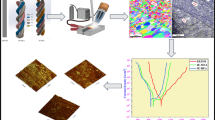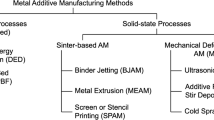Abstract
This work investigates the influence of initial microstructure characteristics on the creep age forming behavior, mechanical anisotropy and fatigue crack growth resistance of creep age formed components. Components made by 2050 Al–Li alloy with fine, coarse and fibrous grain structures were prepared. The results indicate that the components with fibrous grains significantly increases the creep strain, which were generated by large-strain pre-deformation. Additionally, these components exhibit the highest yield and ultimate tensile strengths. On the other hand, components with coarse grains demonstrate superior fatigue crack growth resistance compared to other microstructures. Conversely, components with fine grains exhibit the lowest in-plane anisotropy value. The fatigue crack growth resistance of the three microstructures follows a descending order of coarse grains, fine grains, and fibrous grains. For applications requiring less anisotropy, the AA2050 alloy with fine grains is recommended. Conversely, the alloy with coarse grains is suitable for components subjected to cyclic loading. Lastly, the alloy with fibrous grains is ideal for structural components due to its high ultimate tensile strength and creep strain.
Graphic Abstract















Similar content being viewed by others
References
R.K. Gupta, N. Nayan, G. Nagasireesha, S.C. Sharma, Development and characterization of Al–Li alloys. Mater. Sci. Eng. A 420, 228–234 (2006). https://doi.org/10.1016/j.msea.2006.01.045
Ph. Lequeu, K.P. Smith, A. Daniélou, Aluminum-copper-lithium alloy 2050 developed for medium to thick plate. J. Mater. Eng. Perform. 19, 841–847 (2009). https://doi.org/10.1007/s11665-009-9554-z
L.H. Zhan, J.G. Lin, T.A. Dean, A review of the development of creep age forming: experimentation, modelling and applications. Int. J. Mach. Tools Manuf. 51, 1–17 (2011). https://doi.org/10.1016/j.ijmachtools.2010.08.007
M.C. Holman, Autoclave age forming large aluminum aircraft panels. J. Mech. Work. Technol. 20, 477–488 (1989). https://doi.org/10.1016/0378-3804(89)90055-7
J. Schijve, Fatigue damage in aircraft structures, not wanted, but tolerated? Int. J. Fatigue 31, 998–1011 (2009). https://doi.org/10.1016/j.ijfatigue.2008.05.016
Y.Q. Chen, S.P. Pan, M.Z. Zhou, D.Q. Yi, D.Z. Xu, Y.F. Xu, Effects of inclusions, grain boundaries and grain orientations on the fatigue crack initiation and propagation behavior of 2524–T3 Al alloy. Mater. Sci. Eng. A 580, 150–158 (2013). https://doi.org/10.1016/j.msea.2013.05.053
N. Kamp, N. Gao, M.J. Starink, I. Sinclair, Influence of grain structure and slip planarity on fatigue crack growth in low alloying artificially aged 2xxx aluminium alloys. Int. J. Fatigue 29, 869–878 (2007). https://doi.org/10.1016/j.ijfatigue.2006.08.005
M.N. Desmukh, R.K. Pandey, A.K. Mukhopadhyay, Effect of aging treatments on the kinetics of fatigue crack growth in 7010 aluminum alloy. Mater. Sci. Eng. A 435–436, 318–326 (2006). https://doi.org/10.1016/j.msea.2006.07.063
C. Liu, Y.L. Liu, L.Y. Ma, S.B. Li, Precipitate evolution and fatigue crack growth in creep and artificially aged aluminum alloy. Metals 8, 1039 (2018). https://doi.org/10.3390/met8121039
Y. Li, Z. Shi, J.G. Lin, Y.L. Yang, B.M. Huang, T.F. Chung, J.R. Yang, Experimental investigation of tension and compression creep-ageing behaviour of AA2050 with different initial tempers. Mater. Sci. Eng. A 657, 299–308 (2016). https://doi.org/10.1016/j.msea.2016.01.074
L.B. Hu, L.H. Zhan, Z.L. Liu, R.L. Shen, Y.L. Yang, Z.Y. Ma, M. Liu, J. Liu, Y.G. Yang, X. Wang, The effects of pre-deformation on the creep aging behavior and mechanical properties of Al–Li–S4 alloys. Mater. Sci. Eng. A 703, 496–502 (2017). https://doi.org/10.1016/j.msea.2017.07.068
Y. Dong, L.Y. Ye, J.G. Tang, X.D. Liu, Q. Sun, The effects of temperature on the creep-aging behavior and mechanical properties of AA2050-T34 alloy. Mater. Sci. Eng. A 796, 140010 (2020). https://doi.org/10.1016/j.msea.2020.140010
Y. Dong, L.Y. Ye, X.D. Liu, B. Ke, T.J. Hu, Creep-aging behaviors of Al-Cu-Li alloy with different grain sizes. J. Alloys Compd. 911, 164992 (2022). https://doi.org/10.1016/j.jallcom.2022.164992
Y. Dong, L.Y. Ye, X.D. Liu, B. Ke, T.J. Hu, Effects of large strain pre-deformation on creep age behavior and microstructural evolution of an Al-Cu-Li alloy. Mater. Lett. 324, 132699 (2022). https://doi.org/10.1016/j.matlet.2022.132699
J.A. Wagner, R.P. Gangloff, Fracture toughness of an Al–Li–Cu-In alloy. Scr. Metall. Mater. 26, 1779–1784 (1992). https://doi.org/10.1016/0956-716X(92)90552-P
G.H. Bray, M. Glazov, R.J. Rioja, D. Li, R.P. Gangloff, Effect of artificial aging on the fatigue crack propagation resistance of 2000 series aluminum alloys. Int. J. Fatigue 23, 265–276 (2001). https://doi.org/10.1016/S0142-1123(01)00159-1
N. Akhtar, S.J. Wu, Macromechanics study of stable fatigue crack growth in Al–Cu–Li–Mg–Ag alloy. Fatigue Fract. Eng. Mater. Struct. 40, 233–244 (2017). https://doi.org/10.1111/ffe.12489
N. Kamp, M.R. Parry, K.D. Singh, I. Sinclair, Analytical and finite element modelling of roughness induced crack closure. Acta Mater. 52, 343–353 (2004). https://doi.org/10.1016/j.actamat.2003.09.019
W. Hu, J.Q. Chen, S. Han, J.J. Xu, J.L. Miao, T. Xing, R.G. Guan, Initial report on the oriented-precipitation of T1-phase in creep-aged Al-Cu-Li single crystal. Met. Mater. Int. 29, 1382–1389 (2023). https://doi.org/10.1007/s12540-022-01307-4
M.J. Starink, N. Gao, N. Kamp, S.C. Wang, P.D. Pitcher, I. Sinclair, Relations between microstructure, precipitation, age-formability and damage tolerance of Al-Cu-Mg-Li (Mn, Zr, Sc) alloys for age forming. Mater. Sci. Eng. A 418, 241–249 (2006). https://doi.org/10.1016/j.msea.2005.11.023
P.W. Li, H.Z. Li, X.P. Liang, L. Huang, Fatigue crack growth behavior of Al-4.41Cu-0.69Mg-0.64Si-0.52Mn alloy forged at different temperatures. JOM 71, 419–425 (2019). https://doi.org/10.1007/s11837-018-3126-3
J.G. Tang, B. Yu, J. Zhang, F.S. Xu, C.J. Bao, Effects of pre-deformation mode and strain on creep aging bend-forming process of AlCuLi alloy. Trans. Nonferrous Met. Soc. China 30, 1227–1237 (2020). https://doi.org/10.1016/S1003-6326(20)65291-8
Y. Estrin, A. Vinogradov, Fatigue behaviour of light alloys with ultrafine grain structure produced by severe plastic deformation: an overview. Int. J. Fatigue 32, 898–907 (2010). https://doi.org/10.1016/j.ijfatigue.2009.06.022
S.S. Zhang, G.L. Zhang, C.X. Wang, New Material Mechanics, 2nd edn. (China Machine Press, Beijing, 2009), p.143
M. Houria, N. Matougui, B. Mehdi, N. Kherrouba, M. Jahazi, Effect of plastic anisotropy on the kinetics of static softening in AA2024–T3 aluminum alloy. Met. Mater. Int. 28, 2042–2058 (2022). https://doi.org/10.1007/s12540-021-01126-z
S.A. Saltikov, The determination of the size distribution of particles in an opaque material from a measurement of the size distribution of their sections, in Stereol: Proceedings of the Second International Congress for STEREOLOGY, ed. by H. Elias. Chicago, 8–13 April 1967 (1967). https://doi.org/10.1007/978-3-642-88260-9_31
Y.Z. Li, G.J. Zeng, D.D. Lu, Z.Z. Liu, S.X. Deng, P.C. Ma, Y.L. Chen, R.F. Zhang, J.F. Li, Effect of sub-structure and precipitation behavior on mechanical properties of Al–xCu–Li alloys. Met. Mater. Int. 29, 3204–3221 (2023). https://doi.org/10.1007/s12540-023-01439-1
J. Zhang, C. Wang, Y. Zhang, Y.L. Deng, Effects of creep aging upon Al-Cu-Li alloy: strength, toughness and microstructure. J. Alloys Compd. 764, 452–459 (2018). https://doi.org/10.1016/j.jallcom.2018.06.103
N. Zhao, C.Y. Ban, Developing a high-strength Al–Mg–Si alloy with improved electrical conductivity by a novel ECAP route. Met. Mater. Int. 28, 2513–2528 (2022). https://doi.org/10.1007/s12540-021-01152-x
P. Paris, F. Erdogan, A critical analysis of crack propagation laws. J. Basic Eng. 85, 528–534 (1963). https://doi.org/10.1115/1.3656900
P.S. De, R.S. Mishra, C.B. Smith, Effect of microstructure on fatigue life and fracture morphology in an aluminum alloy. Scr. Mater. 60, 500–503 (2009). https://doi.org/10.1016/j.scriptamat.2008.11.032
H. Vafaeenezhad, M. Chegini, A. Kalaki, H. Serajian, Micromechanical finite element simulation of low cycle fatigue damage occurring during sliding wear test of ECAP-processed AA7075 alloy. Met. Mater. Int. 30, 143–166 (2024). https://doi.org/10.1007/s12540-023-01479-7
J.Y. Chen, H. Yin, Q.P. Sun, Effects of grain size on fatigue crack growth behaviors of nanocrystalline superelastic NiTi shape memory alloys. Acta Mater. 195, 141–150 (2020). https://doi.org/10.1016/j.actamat.2020.05.008
K.U. Snowden, E.G. Mehrtens, The calculation of the relaxed creep strain in four-point bending tests. J. Mater. Sci. Lett. 16, 278–280 (1997). https://doi.org/10.1023/A:1018592816349
D. Feng, X.D. Li, X.M. Zhang, S.D. Liu, J.T. Wang, Y. Liu, The novel heat treatments of aluminium alloy characterized by multistage and non-isothermal routes: a review. J. Cent. South Univ. 30, 2833–2866 (2023). https://doi.org/10.1007/s11771-023-5439-9
D. Feng, G.Y. Wang, H.M. Chen, X.M. Zhang, Effect of grain size inhomogeneity of ingot on dynamic softening behavior and processing map of Al-8Zn-2Mg-2Cu alloy. Met. Mater. Int. 24, 195–204 (2018). https://doi.org/10.1007/s12540-017-7324-2
C.A. Davy, K. Han, P.N. Kalu, S.T. Bole, Examinations of Cu-Ag composite conductors in sheet forms. IEEE Trans. Appl. Supercond. 18, 560–563 (2008). https://doi.org/10.1109/TASC.2008.922510
F. Wei, Z.G. Zhang, B. Shi, C. Yang, Effect of rolling deformation on microstructure and mechanical properties of Mg-6Sn-3Al-1Zn alloy. Mater. Res. Express 7, 026516 (2020). https://doi.org/10.1088/2053-1591/ab6e84
G.V. Stepanov, A.V. Shirokov, Modeling of crack propagation kinetics. Strength Mater. 42, 426–431 (2010). https://doi.org/10.1007/s11223-010-9233-1
M. Balbi, M. Avalos, A. El Bartali, I. Alvarez-Armas, Microcrack growth and fatigue behavior of a duplex stainless steel. Int. J. Fatigue 31, 2006–2013 (2009). https://doi.org/10.1016/j.ijfatigue.2008.12.007
C.H. Wu, D. Feng, J.J. Ren, Q.H. Zang, J.C. Li, S.D. Liu, X.M. Zhang, Effect of non-isothermal retrogression and re-ageing on through-thickness homogeneity of microstructure and properties of Al-8Zn-2Mg-2Cu alloy thick plate. J. Cent. South Univ. 3, 960–972 (2022). https://doi.org/10.1007/s11771-022-4960-6
D.L. Chen, M.C. Chaturvedi, Near-threshold fatigue crack growth behavior of 2195 aluminum-lithium-alloy-prediction of crack propagation direction and influence of stress ratio. Metall. Mater. Trans. A 31, 1531–1541 (2000). https://doi.org/10.1007/s11661-000-0164-5
T.F. Morgeneyer, T. Taillandier-Thomas, L. Helfen, T. Baumbach, I. Sinclair, S. Roux, F. Hild, In situ 3-D observation of early strain localization during failure of thin Al alloy (2198) sheet. Acta Mater. 69, 78–91 (2014). https://doi.org/10.1016/j.actamat.2014.01.033
Acknowledgements
We are grateful for the financial supports of the National Natural Science Foundation of China with Grant numbers U21B6004 and U21A20130.
Author information
Authors and Affiliations
Corresponding author
Ethics declarations
Conflict of interest
The authors declare that they have no known conflict of interest or personal relationships that could have appeared to influence the work reported in this paper.
Additional information
Publisher's Note
Springer Nature remains neutral with regard to jurisdictional claims in published maps and institutional affiliations.
Rights and permissions
Springer Nature or its licensor (e.g. a society or other partner) holds exclusive rights to this article under a publishing agreement with the author(s) or other rightsholder(s); author self-archiving of the accepted manuscript version of this article is solely governed by the terms of such publishing agreement and applicable law.
About this article
Cite this article
Dong, Y., Ye, L., Wang, P. et al. Effect of Initial Microstructures on Planar Tensile Anisotropy and Fatigue Crack Growth of Creep Age Formed 2050 Al–Li Alloy. Met. Mater. Int. (2024). https://doi.org/10.1007/s12540-024-01634-8
Received:
Accepted:
Published:
DOI: https://doi.org/10.1007/s12540-024-01634-8




